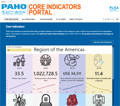
Guadeloupe - Territory Profile
The Health in the Americas+ country profiles are based on the interagency indicators available as of the dates referenced. The sources are referenced in this table. In some cases, the values of the indicators may differ from the most recent data available in the country.
Environmental and social determinants of health
In 2000 the total population of Guadeloupe was 424 067 inhabitants; by 2023 this figure had risen to 395 839, representing a -6.7% decrease. Regarding the country’s demographic profile, in 2023 people over 65 years of age accounted for 20.6% of the total population, an increase of 10.7 percentage points compared to the year 2000. In 2023, there were 121.3 women per 100 men and 115. older people (65 years or older) per 100 children under 15 years of age, as can be seen in the country’s population pyramids, distributed by age group and sex (Figure 1). Considering the population between 15 and 64 years of age to be potentially active (i.e., potential participants in the labor force), this group represented 61.6% of the total population of the country in 2023 (243 650 people). When we add these figures to the potentially passive population (70 795 under 15 years of age and 81 395 over 65 years of age), the result is a dependency ratio of 62.5 potentially passive people per 100 potentially active people. This ratio was 54.2 in 2000.
Life expectancy at birth in 2023 was 83.3 years, higher than the average for the Region of the Americas and 5.9 years higher that in 2000.
Figure 1. Population pyramids of Guadeloupe, years 2000 and 2023
The unemployment rate in 2019 was 28.7% of the total population. In addition, 34.5% of the population was below the national poverty line in 2017. The literacy rate in Guadeloupe was 96% in 2014. Among men, this indicator rose to 95.5%, while among women, it was 96.4%.
Health situation
Maternal and child health
Between the years 2010 and 2021, infant mortality decreased from 7 to 5.8 per 1 000 live births. This represents an increase of 17%.
In the specific case of adolescent fertility, there has been a 34.7% reduction, from 21.6 live births per 1,000 women aged 15 to 19 years in 2000 to 14.1 in 2021. also recorded a percentage coverage of births attended by trained personnel of 100% by 2016. The percentage of low-weight births (less than 2500 g) maintained in 10.1% between 2003 and 2015.
In the specific case of adolescent fertility, there was a 62.6% decrease, from 25.1 live births per 1000 women aged 15 to 19 years in 2000 to 9.4 in 2023. In 2016, 100.0% of births were attended by skilled birth personnel.
Communicable diseases
In turn, the rate of new HIV diagnoses per 100 000 population was estimated at 18.6 for 2017.
Noncommunicable diseases and risk factors
In Guadeloupe, the prevalence of tobacco use among people aged 15 and older was 16,5% in 2014. The prevalence of diabetes mellitus was 8.1 in 2013.
Mortality
The crude mortality rate was 8.9 per 1000 population in 2019, an increase of 25% compared to 2009 (7.1 deaths per 1000 population).
Status of the COVID-19 pandemic
In 2020, a total of 8 620 cases of COVID-19 were identified in Guadeloupe, representing 21 543.2 per million inhabitants. In 2021, 47,175 cases were identified, equivalent to 117,933.7 per million inhabitants in the country. In terms of deaths directly caused by COVID-19, in 2020, 155 deaths of persons diagnosed with COVID-19 were recorded in Guadeloupe, or 387.4 per million inhabitants, while in 2021, the country recorded 676 deaths due to COVID-19, representing 1 689.9 deaths per million inhabitants. In the Region of the Americas, Guadeloupe ranked 27th in the number of deaths from COVID-19 in 2020 and 27th in 2021.
By December 31, 2021, 37% of the country's population had at least one dose of the COVID-19 vaccine. By April 20, 2022 (the latest available data), 35% of the population was fully vaccinated. The vaccination campaign started on January 20, 2021, and 6 types of COVID-19 vaccines have been used so far in the country.
Figure 7. Cumulative COVID-19 deaths in the Region of the Americas, to 31 December 2022
The sources of the interagency indicators used in this profile can be found in this table.
 For the latest data on health indicators for the Region of the Americas, be sure to visit the PAHO Core Indicators portal.
For the latest data on health indicators for the Region of the Americas, be sure to visit the PAHO Core Indicators portal.
COUNTRY/TERRITORY PROFILES
Anguilla
Antigua and Barbuda
Argentina
Aruba
Bahamas
Barbados
Belize
Bermuda
Bolivia
Bonaire, Sint Eustatius, and Saba
Brazil (English) (Português)
Canada
Cayman Islands
Chile
Colombia
Costa Rica
Cuba
Curaçao
Dominica
Dominican Republic
Ecuador
El Salvador
French Guiana, Guadeloupe and Martinique
Grenada
Guatemala
Guyana
Haiti (English) (Français)
Honduras
Jamaica
Mexico
Montserrat
Nicaragua
Panama
Paraguay
Peru
Puerto Rico
Saint Kitts and Nevis
Saint Lucia
Saint Vincent and the Grenadines
Sint Maarten
Suriname
Trinidad and Tobago
Turks and Caicos Islands
United States of America
Uruguay
Venezuela
Virgin Islands (British)
Virgin Islands (U.S.)


